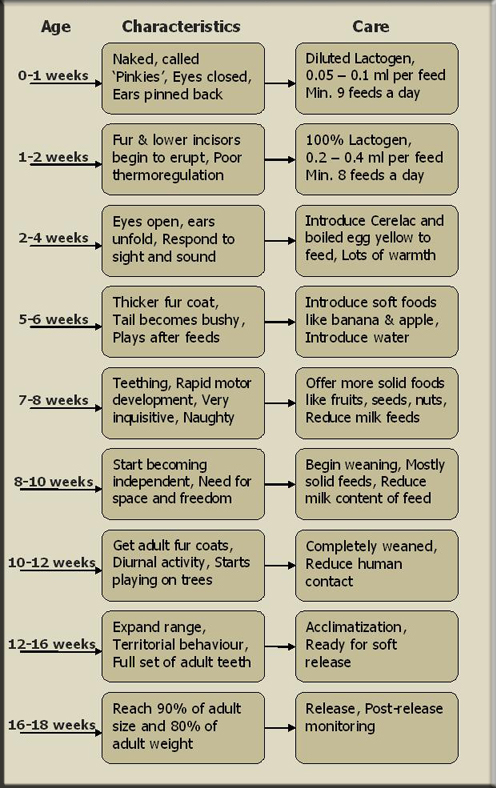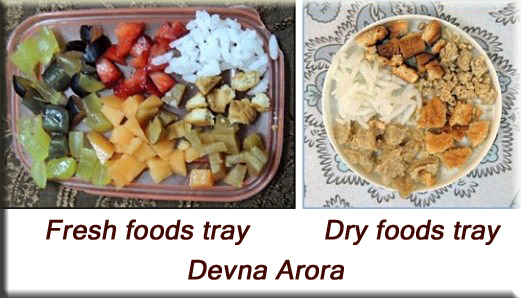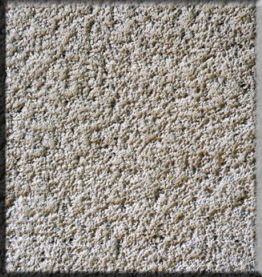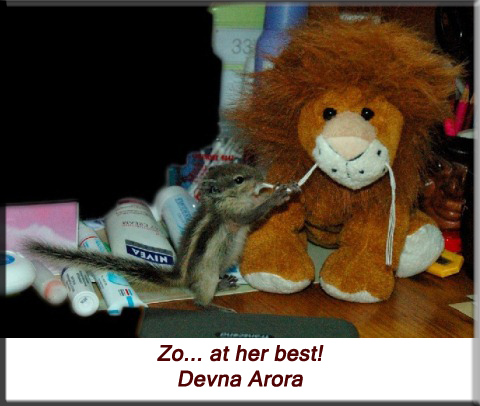Hand-rearing and rehabilitation of orphaned palm squirrels,
Funambulus sp. (revised) contd.
Devna Arora
Link to Page 1: general guidelines
Summary of the stages of development of Indian palm squirrels

Stages of growth and the corresponding care for the kits
The feed quantities outlined below are the quantities required by an average-sized squirrel. Some young are born bigger and may require and consume larger quantities of feed than the ones outlined below. Likewise, there may be some individuals that are smaller or weaker and may consume smaller quantities of feed until their health picks up. Fresh arrivals also tend to accept smaller quantities of feed until they have stabilized and have settled down and adjusted to the handling and feeding. The young must be monitored continually to ensure that they look healthy and satisfied.
Week 1
New-born squirrel babies, commonly referred to as ‘Pinkies’, are born naked and pink in colour with eyes tightly closed and ears closely pinned back. Although they are born naked, the stripes on the back are clearly visible. The young are 3–4 cm long at birth, with a 2–3 cm long tail and weigh 5-8 grams. The young are extremely delicate at this stage of life and need rather tender handling and care.
Feed: [Please refer to the note on Formula on the previous page] The pinkies must initially be started on a diluted feed with a ratio of 70:30 milk formula to water. This also helps to address mild dehydration. The feed may be increased very gradually to 100% of milk formula over a week once the kits appear to digest the feed well. It is advisable to add half a tiny droplet of vitamin drops, after stabilizing the young, to any two feeds of the day, preferably one in the morning and one in the evening. It is also necessary to dust a very tiny amount of probiotic powder on to alternate feeds. Care must be taken not to add much of either vitamin drops or probiotic powder to the feed as the feed quantity is minuscule.
Quantity per feed: The young will consume roughly 0.1 ml per feed for the first few days of their life. The quantity must gradually be increased by 0.05–0.1 ml per feed over the course of the week. The young should consume roughly 0.2 ml per feed by the end of the first week. The kits must be allowed to have a tummy-full if they prefer to feed more, but they must never be forced un-necessarily as it only does them more harm than good.
The new born must consume at least 1 ml of feed every day for the first few days of its life, and a minimum of 1.5 ml every day by the end of the first week. If the young seem to consume less than the minimum daily average, it will be crucial to increase the frequency of feeds, but never the quantity of the feed, to make up the daily average.
Feeding frequency: Pinkies require a minimum of 8-9 feeds per day. Each feed should be 2–2½ hours apart. Feeding must begin by 5-6 am and continued until midnight. Feeding through the night is absolutely unnecessary and the new-borns can be given a 4-6 hour gap between their feeds at night. Each feed must take 4-5 minutes and the flow of the feed must be adjusted accordingly. At this stage, it is best to just drop extremely tiny droplets on the kits tongue, allowing her to swallow slowly. It is vital not to hasten the speed of the feed as it can easily result in aspiration in the young of this age.
N.B. 1 ml = roughly 20 drops; 0.1 ml = roughly 2 drops
These two drops must be divided into at least 5-10 potions and then fed to the young over a few minutes.
Special care: The normal body temperature of squirrels in 100˚C – 102˚C. The young must therefore always feel slightly warm on touch. Pinkies must be kept warm and require an ambient temperature of 27˚C – 29˚C for the first couple of weeks of their life. They will require a warm (never hot) hot-water bottle throughout the day when kept at room temperatures, particularly in colder weather. The hot-water bottle must be checked every time the young are fed as it needs to be refilled with warm water every 3-4 hours. Babies found during the hot Indian summers may not require a hot-water bottle during the day but this will be subjective to the housing conditions and the kit’s health.
Week 2
The young rapidly put on weight in the first few weeks of their lives, their skin pigmentation gradually becomes darker and teeny bits of hair begin to cover the entire body. There is a noticeable slit in the eyelids, the ears start to unfold and the lower incisors begin to erupt in the second week. The kits begin to respond to sounds by the second week of their lives.
Feed: Same as the feed for week 1. Boiled egg yolk can be introduced to their feed in a couple of feeds every day.
Quantity per feed: The young would consume 0.2 ml per feed by the beginning of the second week. The feed must gradually be increased by 0.05–0.1 ml per feed every other day and the quantity of feed must be brought up to 0.4 ml per feed by the end of the second week.
Feeding frequency: The young require at least 7-8 feeds a day. Each feed should be 2½–3 hours apart and the pinkies can now be given 6 hour gap between their feeds at night.
Special care: Same as that for Pinkies of a week’s age.
Week 3
The kit’s eyes start to open in the 3rd week, typically at/after 15 days of age. The kits slowly start responding to visual stimuli by the end of the 3rd week.
Feed: A quarter scoop of Cerelac and roughly 10% of an egg yellow can be added to the day’s feed initially while introducing the kits to the new feed. A tiny droplet of gripe water can also now be added to alternate feeds. [Please refer to the note on Formula on the previous page].
Quantity per feed: The feed must gradually be increased to 1.0–1.2 ml per feed when they are on 7 feeds a day and up to 1.5 ml per feed for 6 feeds a day. The young should now consume an average of 9 ml of feed each day.
Feeding frequency: The kits must be given 6-7 feeds a day at the beginning of the week and the frequency of the feeds can gradually be reduced to 6 feeds a day. Each feed should be 2½–3 hours apart. The kits can now be given a 6-7 hour gap at night.
Special care: The kits may now be housed at ambient temperatures of 25˚C and will require some additional warmth when kept at room temperatures. The warmth of the hot-water bottle can now be reduced during the day, unless it is a chilly day, as the young now have a small coat of fur and hence some additional warmth. Thermoregulation is also sufficiently developed at this stage and they retain heat better.
Week 4
The squirrels will now start to move around and play a bit after their feeds, much like a little puppy. They must be tucked back into their box once they finish playing as they will now sleep until their next meal.
Feed: Same as the feed in week four but the quantity of egg yellow and Cerelac can now be increased. Soft and easily digestible fruits like banana and apple should be introduced at this stage even though the kits will only initially lick and suck the juice of the fruit for the first few days before they start to nibble on the fruit itself.
Quantity per feed: The feed quantity must gradually be increased to 2–2½ ml per feed.
Feeding frequency: The frequency of feeds can now gradually be brought down to 5 feeds a day with a gap of 3 hours between each feed. The kits can now be given an 8-hour gap between their feeds at night.
Special care: A hot-water bottle will no longer be required during the day unless it is a chilly day. The kits must nevertheless be housed in a warm and dry place. The warmth of the hot-water bottle at night can also now be reduced.
Week 5
The kits start becoming active at the age of a month. They must be given plenty of freedom to run around and play in order to get exercise and for their muscles to develop well.
Feed: The ratio of Cerelac in the feed (for the entire day) can now be increased to 1 scoop and egg yellow to 1/4th of the egg. The vitamin and paediatric drops too can be increased to 2 drops of each in alternate feeds.
Solid foods should now be introduced into the kit’s diet. The kits will be least interested in new foods when on a full stomach and solid foods must therefore always be offered before the feed, when the kits are hungry, i.e., an hour before their feed. This encourages them to taste and eat the new food offered.
As the kit’s reliance on solid foods begins to increase and their feed becomes thicker (especially with the addition of Cerelac and egg yellow), they will require additional water to maintain their hydration levels. A fresh bowl of water must be offered to the kits every day now onwards as they will start to drink water by this stage. It may take them a day or two to learn to angle their mouths correctly and keep their nose out of the bowl, but they’ll get there.
Caution: The kits must initially be offered solid foods only when under supervision as they sometimes swallow too big a morsel of food which may get stuck in their throat. This is most likely to happen when there is more than one young and the kits try to eat hurriedly in competition with one another.
Quantity per feed: The quantity of feed must gradually be increased to 3–4 ml per feed.
Feeding frequency: The feeds must gradually be reduced to 4 meals a day, 3-4 hours apart. The kits can now be given a gap of 8-10 hours between their feeds at night. They must also be given plenty of solid foods throughout the day.
Special care: The squirrels will now start becoming very active and inquisitive and will want to thoroughly explore their surroundings. It is extremely important to squirrel proof the house especially if hand-raising the young from home. You must ensure that nothing can accidentally fall on them. All important documents, wires, laptops, etc. must be kept out of reach as they will now also start to nibble on everything.
Week 6
The kits are very inquisitive and naughty by this stage. If you remember watching the cartoon Chip ‘n Dale as a child, I would say that they are exactly as that! They also start teething by this age and will chew on anything soft that they can sink their teeth into.
Feed: The kits must consciously be shifted onto solid foods by now. Including solid foods early on in their diet eases the transition from milk to solid foods during weaning. Solid foods offer the additional benefit of giving the kits something to chew on thereby providing some exercise for their teeth and easing the teething process as well.
More fruits like grapes (they absolutely love grapes), pomegranates, melons, cherries, berries, etc. and soft nuts like cashews, melon seeds, sesame seeds, sunflower hearts, etc. can now be offered to the kits. They can also be offered a variety of foods like bread, rice, corn, sprouts, cake, banana loaf, etc. It is important to keep low on artificial sugar though as it’s not very healthy and they end up on a complete sugar rush! It is nevertheless important to let them be used to a varied diet so that they remain flexible enough to eat whatever they can find once they’re on their own.
Quantity per feed: The quantity of the feed can be increased to 5 ml per feed.
Feeding frequency: The kits now require 4 feeds a day, 4 hours apart, with lots of titbits in-between.
Special care: The kits will now seek out warm places in the house like blankets, pillow cases, cushions, jackets, internet modems, etc. when they want to rest. Ensure to always check thoroughly and know where the kits are before you sit down.
As the kits explore their surroundings and look for new spaces to get into and sleep, you can also hang a bag (preferably a cotton or canvas bag) close to their nesting box and they will likely prefer sleeping in the bag rather than returning to a box on the ground. Just leave adequate entrance space for them. The bag may be lined with a soft cotton towel. You can also leave them bits of wool or jute for them to carry back to their new ‘nests’ and line them up to their satisfaction. Refrain from hanging a bag if the kits still require a hot-water bottle at night – dependent on weather conditions.
Example of feeding trays during and after weaning

Week 7
The kits will play and play-fight a lot by this age. If hand-raising just one squirrel, it will be very important to spend a lot of play time with him/her as play-fighting hones their fighting abilities in the wild and is essential for their survival. If hand-raising more than one squirrel, they will play amongst themselves and require less attention from you.
Feed: The milk content of the feed must now be reduced and the Cerelac (wheat based) content increased. As the milk content of their feed decreases, the addition of probiotics to their feed too can be reduced. Fresh food and water must be available for the kits at all times, and more foods like almonds, walnuts, peanuts (with/without shells), etc. must also be introduced.
Quantity per feed: The kits would now consume 5–7 ml per feed but larger feeds must not be encouraged. As their reliance on solid foods increases, the daily average of feed consumed by the kits can now be reduced. Ensure that the kits have some solid foods before their feed so they don’t require a heavy feed. Kits that take longer to adjust to solid foods must be given an adequate feeds as it would negatively affect their growth otherwise.
Feeding frequency: The kits can now be brought down to 3 feeds a day – one feed each in the morning, afternoon and night. They will have their last meal much after sundown between 8-10 pm at night and can now be given a 10-12 hour gap between their feeds at night.
Special care: Although there will be no need for a hot-water bottle at night any longer, there must be ample amounts of warm bedding for the kits to keep warm.
Week 8
The kits now start adjusting to daylight hours and would prefer an uninterrupted sleep of about 12 hours at night. They might also now prefer spending a few hours at the window watching everything that goes on outside the house. This is a sign that the young are getting ready to explore the outside world. The kits will have achieved more than 70% of their total growth by the end of the 8th week.
Feed: Consider stopping additional milk altogether and give the kits a mix of Cerelac and egg yellow now. Cerelac contains about 35% milk and is more than adequate for the kits. The probiotics too can now be discontinued. The kits droppings, much like an adult squirrel’s, would now consist of elongated black pellets.
Quantity per feed: The kits may be offered a feed of 5-7 ml each but the feed quantity must not be increased too much as the kits should now get most of their energy from solid foods. The feed must only be to supplement their diet and act as a means of offering solace rather than a purely dietary prerequisite for the young.
Feeding frequency: The kits can now be given 2 feeds a day – one feed each in the afternoon and late evening. It is important to refrain from giving the kits a feed in the morning as it encourages them to eat solid foods. You must ignore the kits initially if they seem to pester for a morning feed.
Special care: It is essential that the kits get plenty of exercise for good muscle development, co-ordination, gastro-intestinal tract functioning and learning. This must be encouraged by providing suitable play facilities for the young. Sunlight too plays an important factor in the development of the young and lack of the same can result in rickets.
Habitat enrichment
It is extremely important to start providing enrichment for the kits by the time they reach two months of age. The kits are extremely curious at this age and require supplementary stimulation to maintain their curiosity. This may simply achieved by shifting things around a little bit so the kits always have something to explore.
Hanging or hiding their food also helps as they will learn to search for their food. The food may be shifted around, giving them the opportunity and need to explore further.
This process is vital for squirrels being released through a hard release process as squirrels under a soft release will have adequate stimulation once they are allowed to roam outside.
2 – 3 months
Young squirrels get their adult coats which are darker, thicker, and very sleek, by 2½–3 months of age. It is interesting to note that some squirrels also get a linear marking on their foreheads at this age. This marking seems to disappear in a few weeks by the time they attain their full growth. The squirrels also get their complete set of adult teeth by 12–13 weeks of age. The kits would now have completely adjusted to being active during daylight hours, i.e., up by sunrise and back in bed by sunset. The process of rehabilitation and soft release begins at this age.
Feed: A feed of Cerelac along with vitamin drops and gripe water would now suffice the kits nutritional needs. They could also be offered their bedtime feed in a small saucer as the quantity of feed doesn’t need to be monitored strictly anymore. This is also an ideal time to start breaking off contact with the young. Ceasing to hand-feed facilitates this process.
Squirrels are opportunistic feeders and will now begin to explore a variety of foods including leaves, buds, flowers, grasses, berries, etc. Their diet in the wild also occasionally includes insects and bird’s eggs and chicks.
Quantity per feed: The kits would now need a feed of 7–8ml but they must be allowed to have a tummy-full should they ask for more.
Feeding frequency: The kits only need their bed-time feed now, preferably late in the evening, i.e., around or a little after sunset. This ensures that the kits are tempted to eat during the day but don’t go to bed on an empty stomach at night. The feeds can be completely stopped by 10-11 weeks of age.
Special care: The kits must be allowed to roam outside the room/enclosure where it is feasible. An access door or window can be left open for the kits to freely move in and out of the room/enclosure. The kits must never be allowed access to other rooms of the house as it is extremely dangerous for them. Their playground must always be outside the house. They must only be let out for a few, strictly supervised hours initially to ensure their safety from predators. They will gradually start staying away for longer durations.
Most animals show remarkable site fidelity and homing instincts. Animals released at new sites typically attempt to return to the place they have grown up in. This journey towards ‘home’ results in their taking higher risks that often have fatal consequences. The kits must ideally be given the opportunity to familiarize and associate themselves with the environment they will subsequently be released in. The cage or enclosure must therefore be placed at the site of release to encourage the kits to get familiar with the new environment, thereby assisting safe release.
3 – 4 months onwards
The squirrels will now be away most day and only return for quick snacks during the day and to sleep at night. As their confidence increases, they will slowly expand their range and wander further away from their room and enclosure. By 4 months of age, they would stop returning at night but may still drop by occasionally during the day.
Special care: Being primarily arboreal in nature, the palm squirrels instinctively prefer to sleep in spaces at a height. Retiring in enclosed spaces higher up in trees or eaves of houses affords them safety from terrestrial predators. Consider hanging a box or even a bag somewhere high up in the room by the time the kits are 3 months old. For e.g., hang a cardboard box behind some curtains so they can climb up the curtains and get some privacy too. Depending upon the season, a warm blanket or towel may be placed inside the bag or box for bedding.
Release
Soft Release is a means by which the animal is gradually introduced or familiarized to a new environment before its release into that location.
Hard Release is a means by which the animal is released into a new location without its being accustomed to the new environment. Squirrels that have been rescued as adults are able to cope better with a hard release as they have already learnt all the skills necessary for their survival.
It is ideal to opt for a soft release for hand-raised young. Hand-raised young have to learn all new skills through a method of ‘trial and error’ as they have no adults to teach or show them the essential survival skills by way of example. They also have to offset the effects of imprinting and hence require more time and protection before they are completely independent. A soft release, which permits them to return to security until they are ready for complete independence, thus maximizes their chances of survival.
The young must always whenever possible, be released in their natural environments, at or close to the location of rescue. This not only maximizes the animal’s survival but also keeps a check on the contrived spread of parasites, diseases and genetic materials within wild populations. Forest species must only be released in suitable forested locations where the species naturally occurs.
N.B. Once the process of acclimatization and release begins and he squirrels start interacting with wild squirrels outside, they must be handled carefully. Avoid startling them as they may instinctively bite.
Allowing access
An access door or window to the enclosure can be left open for the squirrels. The access door should be slightly bigger than the squirrels to allow easy and comfortable movement through it. Preferably, the opening shouldn’t be too big so as to prevent access to larger predators. Wherever possible, the opening should take the squirrels onto higher ground to facilitate escape from terrestrial predators in case of a sudden threat. Windows are therefore preferable to doors for this purpose.
To provide outdoor access for the young from an apartment, a makeshift ramp may be used to connect the window to a tree outside. This is extremely effective for a soft release. The ramp can be made of wooden planks or by twining rope around a piece of bamboo and must be secured firmly so it doesn’t dislodge accidentally. The surface or the ramp mustn’t be smooth or slippery. The squirrels use the ramp with ease and play in the garden and return home when they need to. This is extremely helpful for enhancing their motor skills and boosting their agility.
The ramp is not recommended as a safe option for apartments higher than the first floor as young squirrels in the initial stages of their exploration and excitement, sometimes fall off the ramp.
The kits must always have access to a safe area to return to when they are threatened as there will be many predators like cats, dogs, shikras (small hawks), crows, snakes, etc. that can threaten a young squirrel. When leaving an access window/door open for the squirrels, especially from an outdoor enclosure, it is extremely important to shut the access after sunset to prevent access to nocturnal predators. The access door must be reopened at sunrise for the squirrels to be let out again.
The enclosure can be closed or shifted out by the time the kits are 4 to 4 ½ months of age. The kits are independent enough to survive on their own by this age. Additionally, temporary nest boxes can be placed in the vicinity of release as a place for the squirrels to return to until they find a more permanent space.
Soft release from an apartment building
 Young squirrels may be released from apartment buildings too. It is not uncommon to find squirrels scaling the walls of rough-surfaced buildings. In fact, squirrels in some apartment colonies have little access to tress, but live on buildings, nest above windows and/or ACs and thrive on the mercy of food provided by kind people.
Young squirrels may be released from apartment buildings too. It is not uncommon to find squirrels scaling the walls of rough-surfaced buildings. In fact, squirrels in some apartment colonies have little access to tress, but live on buildings, nest above windows and/or ACs and thrive on the mercy of food provided by kind people.
The main considerations to be kept in mind when releasing the squirrels from apartment buildings is,
1. The texture of the outer surface of the building
It goes without saying that such an option is only available to people whose apartment buildings are rough-surfaced on the outside. This is definitely not a perfect option but a good indication of whether or not your buildings is suitable for squirrels would be the presence of wild squirrels in and around your building. In all cases, you would not want to release your squirrel in an environment where it is the only one.
2. The age of the squirrels during release
Another primary consideration to be kept in mind is that it is not safe or easy to run on vertical surfaces that don’t provide adequate footing and it takes a lot of agility and practice from even an adult squirrel so it doesn’t fall off. Young squirrels are yet to acquire this agility and sense of balance before expecting them to confidently scale buildings. In my experience and understanding, if opting for such a release, the young squirrel must be at least 2 ½–3 months of age before allowing it to run on the outside walls.
3. Marking the exits/access for safe return
Lastly, you must remember that all apartments in a building look exactly the same from the outside. Once outside, it is difficult for the squirrels to locate YOUR balcony or window and return home. Often, the squirrels get confused and end up at somebody else’s place. If you have ever been lost in a new and unfamiliar housing complex, with no markings or directions whatsoever, you will know what I am making a reference to.

It is imperative here to mark your balcony or access opening and let the squirrel familiarize itself with the marking for at least a week or two before permitting it to play outside. The marking, for example a bed sheet or netlon, must be tied outside and preferably protruding from the balcony so it can be easily spotted from a distance when on the building. Although this isn’t perfect science, we have found it extremely helpful in previous experiences.

Tips for a hard release
A hard release can ideally be carried out when the young are 4 months old. The release site must be chosen beforehand to ensure there are ample fruit/seed trees in its vicinity. It is imperative to choose a site with no apparent predators. The squirrels must not be released close to any major roads, water bodies or any other perceivable threats.
The young must be released on a clear and sunny day. Special care needs to be taken during the monsoons. The young must be released during a dry spell even if it takes a few extra days.
The kits should be released immediately after their breakfast so they can devote all their energy in exploring the new place rather than worrying about food. If not, they must be released first thing in the morning. The kits will require time to explore the new territory and find a safe shelter for themselves. They must never be release into new territories any later than midday especially in winter due to shorter daylight hours.
Territoriality
Territoriality, though rarely observed in palm squirrels, is often dependent upon the availability of resources. Although some adults do display territorial behaviour, they are rarely viciously aggressive towards other squirrels.
Letting go
One of the most challenging aspects of being a rehabilitator or any foster parent is letting go of the young when they are ready for release. Even though this is primarily out of a concern for their safety and well-being, it is important to realize and suitably respond to the young one’s needs. The young must be released at the right time as their mind and bodies are best suited for adapting to novel environments and surroundings at that age. Once they are past that age, they too become set in their in their ways and needs and find it very difficult to adapt to their natural surroundings.
Wild animals do not make good pets. They have an innate need for freedom and exploration that cannot be placated by offering them the security of a safe, sheltered and comfortable lifestyle. This need is most pronounced when the young mature sexually. There isn’t a sorrier sight that watching a wild animal pacing in an enclosure or sitting endlessly beside a window and staring at the myriad opportunities that await him/her outside. Moreover, there is no greater joy than watching your very own hand-raised young be happy and free outside, and return periodically for tit-bits or to just say hello!
A lil’ word of thanks!
This book is dedicated to Zoe, the craziest squirrel I’ve ever known!
My life has been enriched for having known you and cared for you.

I owe the success of my efforts to the guidance, generosity and encouragement of many. A special thanks you is due to,
The team at Snake Park (Pune), esp. Mr. Rajan Shirke, Mr. Baba Patwardhan and Mr. Aniket Bhukan for giving me a chance to join the field of animal care, for their ever watchful guidance and the values they have instilled in me. Dr. Brijesh Raj, Dr. Anirudh Belsare, Dr. Deepak Tulpule, Dr. Pooja Tulpule, Dr. Anjali Davé, Dr. Gowri Mallapur, Dr. Amol Khedgikar and Ms. Vaishali Ghotikar for their generous help and support over the years.
Aparajita Kumar, Dr. NVK Ashraf, Arjun Anavangote and Radhika Bhagat for their sincere appreciation, encouragement and suggestions to enhance the initial protocol in 2010-11. Sneha Shirsekar, for her practical application of the first protocol and feedback on the same.
My parents, Ahilya Arora and Krishan Lal Arora, for giving me the chance to follow my dreams, and for putting up with all my little ones and all the damage we do to the house ~ and trust me, it’s a lot! Ms. Gover Mistry, my dear friend and guide, for being there unconditionally to support me always and share my dreams.
All you people who put words into action, God bless your efforts!
To Debs, Ngaio ‘n Varsha, my words belittle my feelings but your presence has been of paramount importance to my life.
“Debby, my first love and best friend, I miss you dearly. Your absence is felt every single day of my life!”
“Ngaio Richards, my dear friend, you’re an inspiration! Your sincere appreciation, understanding and thoughtfulness mean the world to me.”
“Varsha Belagavi, my partner in crime, you’ve always been there no matter what!”
Thank you :o)
References
Blanford, W.T. (1888-91). Mammalia. In Blanford W.T. The Fauna of British India, Including Ceylon and Burma. London: Taylor and Francis, pp. 383-384. [Online] Available from:
http://www.archive.org/details/mammalia00blaniala
[Accessed 19/07/09].
Bourne, D. (undated). Wildlife Casualty Release. [Online] Available from:
http://usgs.wildlifeinformation.org/s/00Man/ukfirstaidandcare/Wildlife
CasualtyRelease.htm [Accessed 24/11/10].
Breed, M.D. (2010). Both Environment and Genetic Makeup Influence Behavior. [Online] Available from:
http://www.nature.com/scitable/knowledge/library/both-environment-andgenetic-makeup-influence-behavior-13907840 [Accessed 18/10/10].
Casey, S.J. and Casey, A.M. (2002). Mammal Nutrition. [Online] Available from:
http://www.ewildagain.org/pdf/MammalNutritionNWRA.pdf [Accessed 22/01/10].
Csurhes, S. (2010). Indian Palm Squirrels. [Online] Available from:
http://www.dpi.qld.gov.au/documents/Biosecurity_EnvironmentalPests/
IPA-Palm-Squirrel-Risk-Assessment.pdf [Accessed 26/02/11].
Cummins, M. (2004). Raising Infant Tree Squirrels. [Online] Available from:
http://www.scarysquirrel.org/special/pets/infant/squirrelmanual.pdf [Accessed 21/05/10].
De A. Goonatilake, W.I.L.D.P.T.S., Nameer, P.O. and Molur, S. (2008) Funambulus layardi. [Online] In: IUCN Red List of Threatened Species. Available from: http://www.iucnredlist.org/details/8700/0 [Accessed: 07/01/2013].
Miller, E.A. (2000). Minimum Standards For Wildlife Rehabilitation. 3rd ed. [Online] Available from: http://theiwrc.org/wp-content/uploads/2010/08/MSWR.pdf [Accessed 14/10/10].
Nameer, P.O. and Molur, S. (2008) Funambulus palmarum. [Online] In: IUCN Red List of Threatened Species. Available from: http://www.iucnredlist.org/details/8701/0 [Accessed: 07/01/2013].
Nameer, P.O. and Molur, S. 2008. Funambulus pennantii. [Online] In: IUCN Red List of Threatened Species. Available from: http://www.iucnredlist.org/details/8702/0 [Accessed: 07/01/2013].
Molur, S. and Nameer, P.O. (2008) Funambulus tristriatus. [Online] In: IUCN Red List of Threatened Species. Available from: http://www.iucnredlist.org/details/8704/0 [Accessed: 07/01/2013].
Purohit, K.G., Kametkar, L.R. and Prakash, I. (1966). Reproduction biology and post-natal development in the northern palm squirrel Funambulus penantii wroughton. Mammalia 30: 538-546 [Online] Available from: http://related.springerprotocols.com/lp/de-gruyter/reproduction-biology-and-post-natal-development-in-the-northern-palm-WK1Q6zNx8l [Accessed 23/02/11].
Rajamani, N., Molur, S. and Nameer, P.O. (2008) Funambulus sublineatus. [Online] In: IUCN Red List of Threatened Species. Available from: http://www.iucnredlist.org/details/8703/0 [Accessed: 07/01/2013].
Roach, P. (1995). The Complete Book of Pet Care. Revised and Updated. Australia: Lansdowne Publishing Pty. Ltd.
Rowe, S. (undated). Care Instructions For Infant Squirrels. [Online] Available from: http://www.squirreltales.org/ [Accessed 14/10/10].
Seebeck, J.H. (1989). Fauna of Australia, Volume 1B Mammalia: 46. Sciuridae, Australian Government Publishing Service, Canberra [Online] Available from:
http://www.environment.gov.au/biodiversity/abrs/publications/fauna-of-australia/pubs/volume1b/46-ind.pdf [Accessed 26/02/11].
Smith, D. (2002) Ground and Tree squirrels In: Gage, L.J. and Duerr, R.S. (2002) Hand-rearing wild and domestic mammals, Iowa State University Press, Blackwell Publishing Professional.
Trendler, K. (2005). The Principles of Care and Rehabilitation of Orphaned Wild Mammals. In: Menon, V., Ashraf, N.V.K., Panda, P., and Mainkar, K. 2005. Back to the Wild. Studies in Wildlife Rehabilitation. Conservation Reference Serious No.2. Delhi: Wildlife Trust of India. pp. 46-53.
Steppan, S.J. and Hamm, S.M. (2006) Scuiridae. [Online] Tree of Life web project. Available from: http://tolweb.org/Sciuridae [Accessed: 08/01/2013].
Further Reading
Author Unknown (undated). Care For Orphaned Squirrels. [Online] Available from: http://www.orphanedwildlifecare.com/ [Accessed 21/05/10].
Bishnupuri, K.S. and Haldar, C. (2000). Impact of photoperiodic exposures during late gestation and lactation periods on the pineal and reproductive physiology of the Indian palm squirrel. Journal of Reproduction and Fertility. [Online] Available from:
http://www.reproduction-online.org/cgi/reprint/118/2/295.pdf [Accessed 23/02/11].
Bourne, D.C. (undated) Hand rearing orphaned wildlife. [Online] Available from:
http://usgs.wildlifeinformation.org/S/00Man/ukfirstaidandcare/
HandRearingOrphans.htm [Accessed 21/02/11].
Bourne, D.C., Lawson, B. and Boardman, S.I. (undated). UK Wildlife: First Aid and Care. [Online] Available from:
http://www.wildlifeinformation.org/Preview_WildPro/contentsmodules/
UK_Wildlife/UKWildlifeCare.htm [Accessed 22/01/10].
Casey, S.J. and Casey, A.M. (2003). Squirrel Rehabilitation Handbook. WildAgain Wildlife Rehabilitation Inc. Evergreen, Colorado. [Online] Available from:
http://www.ewildagain.org/pubs/squirrel%20rehabilitation%20hand
book.htm [Accessed 22/01/10].
Clark, C. (2010) Nipple and Syringe sample set. Chris’s Squirrels & More
[Online] Available from:
http://www.squirrelsandmore.com/product/845/nipple-and-syringe-sample-set.htm [Accessed 03/10/11].
Cummins, M. (2004). Raising infant skunks. [Online] Available from:
http://www.animaladvocates.us/skunkmanual.pdf
[Accessed 24/02/11].
IUCN (1998). Guidelines for Re-introductions. Prepared by the IUCN/SSC Re-introduction Specialist Group, IUCN, Gland, Switzerland and Cambridge, UK [Online] Available from:
http://www.iucnsscrsg.org/download/English.pdf
[Accessed 24/11/10].
RSPCA (undated). Standards for Wildlife Rehabilitation. [Online] Available from:
http://wildlife1.wildlifeinformation.org/s/00ref/miscellaneouscontents/
rspca-rehabilitation/Contents.htm [Accessed 24/11/10].
The Wildlife (Protection) Act, 1972. [Online] Available from: http://www.karnatakaforest.gov.in/English/Acts_Rules/acts/Wildlife_
Protection_Act_1972.pdf [Accessed 31/08/10].
The Wildlife (Protection) Amendment Act, 2002. [Online] Available from: http://envfor.nic.in/legis/wildlife/wild_act_02.htm#http://envfor.nic.in/
legis/wildlife/wild_act_02.htm [Accessed 14/10/10].
The Wildlife Rehabilitator Recruiting Project (2001). Wildlife Rehabilitation: Is It For You? [Online] Available from: http://www.ewildagain.org/pdf/RecBooklet2006.pdf [Accessed 27/02/10].
WILDLIFE International (undated). Wildlife Care. [Online] Available from: http://www.wildlifeinternational.org/EN/rehab/care/release/release.html [Accessed 24/11/10].
Protocol published in 2013





